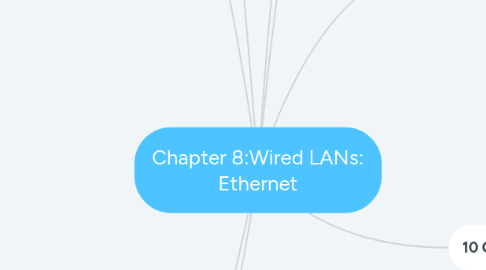
1. 3.Data Link Layer:
1.1. Logical Link Layer(LLC)
1.2. Medium Access Layer (MAC)
2. 4.Ethernet Evolution:
2.1. Standard Ethernet
2.1.1. 10 Mbps
2.2. Fast Ethernet
2.2.1. 100 Mbps
2.3. Gigabit Ethernet
2.3.1. 1000 Mbps
2.4. Ten-Gigabit Ethernet
2.4.1. 10 gbps
3. 5.Standar Ethernet
3.1. 1.Mac Sublayer
3.1.1. FRames data received from the upper layer and passes them to the PLS sublayer
3.1.2. Frame Format:
3.1.2.1. Seven Fields: preamble, SFD,DA, SA,PDU, data and the CRC
3.1.3. Frame Length:
3.1.3.1. Minimum: 64 Bytes and maximum is 1518 bytes
3.1.4. Addressing:
3.1.4.1. 6 bytes and written in hexadecimal notation
3.1.4.2. Source address : Unicast
3.1.4.3. Destination address:
3.1.4.3.1. Unicast = only one recepient, one to one
3.1.4.3.2. Multicast= group of addresses, one to many
3.1.4.3.3. Broadcast= special address case of multicast , recipients are all the stations
3.2. 2.Physical Layer:
3.2.1. 1.Physical Layer Signaling
3.2.1.1. Manchester encoding with 10 Mbps
3.2.2. 2.Attachment Unit Interface(AUI)
3.2.2.1. Defines the interface between PLS and MAU
3.2.3. Medium Attachment Unit(MAU)
3.2.3.1. Transceiver
3.2.4. Medium Dependent Interface
3.2.4.1. Hardware connecting a transceiver to the medium
3.2.5. Physical layer implementation:
3.2.5.1. 10Base5
3.2.5.1.1. Bus,thick coaxial
3.2.5.2. 10Base2
3.2.5.2.1. Bus,Thin coaxial
3.2.5.3. 10BaseT
3.2.5.3.1. Star, UTP
3.2.5.4. 10 BaseF
3.2.5.4.1. Star, fiber
3.3. 3.Bridge Ethernet:
3.3.1. Unbridge ethernet: total capacity shared between all stations
3.3.2. Bridge: Divides the network into two or more networks
3.3.2.1. Advantage: 1) capacity is shared between smaller Stations, 2) Collision domain becomes smaller
3.4. 4. Switched Ethernet
3.4.1. Bandwith is shared between the station and switch
3.5. 5.Full Duplex
3.5.1. send/ received data at the same time simulatneuously.
4. 7.Gigabit Ethernet
4.1. Mac sublayer:
4.1.1. Half duplex using CSMA/CD or full duplex without CSMA/CD
4.2. Physical Layer
4.2.1. RS
4.2.1.1. send 8 bits of data to PHY via GMII
4.2.2. GMII
4.2.2.1. Defines how RS connected to the PHY sublayer
4.2.3. PHY
4.2.3.1. transceiver , encodes and decodes data
4.2.4. MDI
4.2.4.1. Connects the transceiver to the medium and only RJ-45 and fiber optic connectors.
4.3. Implemetations:
4.3.1. 1000Base-SX
4.3.1.1. two wire ,short wave fiber
4.3.2. 1000Base-LX
4.3.2.1. two wire, long wave fiber
4.3.3. 1000Base-CX
4.3.3.1. two wire, copper
4.3.4. 1000Base-T
4.3.4.1. four wire, UTP
5. Ethernet:
5.1. LAN that using CSMA/CD access method
6. IEE Standards:
6.1. Project 802
6.1.1. enable intercommunication among equipment from manufactureres.
7. 6. Fast Ethernet:
7.1. Mac Sublayer:
7.1.1. Access method is CSMA/CD but for duplex no need CSMA/CD
7.2. Physical Layer:
7.2.1. RS sublayer
7.2.1.1. Replaces PLS
7.2.2. MII
7.2.2.1. Replaces AUI , can be used in 10 and 100 Mbps
7.2.3. PHY sublayer
7.2.3.1. transceiver
7.2.4. MDI
7.2.4.1. Hardware connecting the transceiver to medium
7.3. Implemetations:
7.3.1. 100Base-TX
7.3.1.1. Cat 5 UTP, 2 wires, block encoding=4b/5b, line coding=MLT-3
7.3.2. 100-BaseFX
7.3.2.1. Fiber, 2 wires block encoding=4B/5B , line encoding: NRZ-I
7.3.3. 100-BaseT4
7.3.3.1. Cat 4 UTP , 4 wires , block encoding=4B/5B line coding=8B/6T
8. 10 Gigabit Ethernet
8.1. 10G Base TX
8.1.1. shortwave
8.2. 10G Base FX
8.2.1. Longwave
8.3. 10G Base T4
8.3.1. extended 1550 nm

